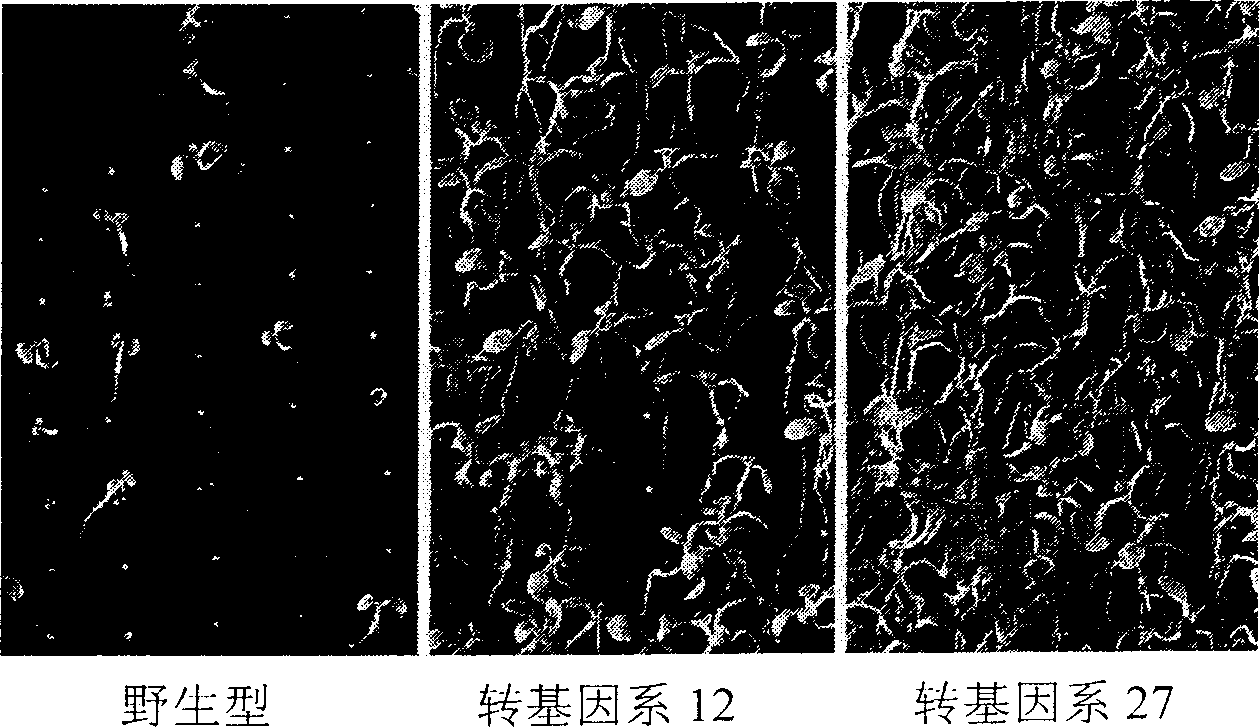Application of polyphosphoinositide 6-3/kinase gene in plant salt resistance
A technology of polyphosphoinositide and Arabidopsis polyphosphoinositide, which can be used in application, genetic engineering, plant genetic improvement, etc., and can solve the problem of using no Arabidopsis polyphosphoinositide 6-/3-kinase gene. Or report and other problems to overcome the impact of plant growth and yield, improve sensitivity, and maintain the effect of yield
- Summary
- Abstract
- Description
- Claims
- Application Information
AI Technical Summary
Problems solved by technology
Method used
Image
Examples
Embodiment 1
[0050] After the polyphosphoinositide 6- / 3-kinase gene (target gene) cloned from Arabidopsis is expressed in the present invention, the salt resistance of the transgenic Arabidopsis is obviously higher than that of the wild type. The polyphosphoinositide 6- / 3-kinase gene was assembled under the cauliflower mosaic virus 35S strong promoter (CaMV35S) with strong constitutive expression, and a vector that could be expressed in plants was constructed, and the transformation mediated by Agrobacterium The method is to make the target gene be expressed in a large amount in the transgenic plant, and the specific operation is as follows:
[0051] 1. Cloning of Arabidopsis polyphosphoinositide 6- / 3-kinase gene
[0052]Inositol 1, 4, 5-trisphosphate kinase sequences in animals were used to search for homologous sequences of inositol 1, 4, 5-trisphosphate kinase in plants in the GenBank database using Basic Local Alignment Search Tool. The polyphosphoinositide 6- / 3-kinase gene sequence f...
Embodiment 2
[0060] 1. Cloning the Arabidopsis polyphosphoinositide 6- / 3-kinase gene from Arabidopsis thaliana by the same method as in Example 1. The Arabidopsis polyphosphoinositide 6- / 3-kinase gene was inserted into the plant expression vector pBinAR-HPT to construct the pBinAR-HPT / AtIP3K expression vector. and transgenic identification. The specific method is operated as in Example 1.
[0061] 2. The screened transgenic seeds were germinated and grown at a concentration of 125mM NaCl, and compared with wild-type Arabidopsis seeds.
[0062] 3. The germination rates of transgenic and wild-type seeds were counted and the growth of seedlings was observed.
[0063] 4. Under the condition of 125mM NaCl, the individual growth of IP3K transgenic seedlings was significantly better than that of wild-type seedlings, such as image 3 Shown, the individual growth of IP3K transgenic seedlings.
[0064] 5. Under the condition of 125mM NaCl, the germination rate of IP3K transgenic seeds was also s...
Embodiment 3
[0066] 1. Cloning the Arabidopsis polyphosphoinositide 6- / 3-kinase gene from Arabidopsis thaliana by the same method as in Example 1. The Arabidopsis polyphosphoinositide 6- / 3-kinase gene was inserted into the plant expression vector pBinAR-HPT to construct the pBinAR-HPT / AtIP3K expression vector. and transgenic identification. Concrete method is identical with embodiment 1.
[0067] 2. The screened transgenic seeds were germinated and grown under 150mM and 175mM NaCl concentrations, and compared with wild-type Arabidopsis seeds.
[0068] 3. The germination rates of transgenic and wild-type seeds were counted and the growth of seedlings was observed.
[0069] 4. Under the condition of 150mM NaCl, the germination rate of IP3K transgenic seeds was also significantly higher than that of wild-type seedlings, such as Figure 5 As shown, the germination rate was increased by 48-55%, by experiment at 50%.
[0070] 5. Statistics on the germination rate of IP3K transgenic plants an...
PUM
 Login to View More
Login to View More Abstract
Description
Claims
Application Information
 Login to View More
Login to View More - Generate Ideas
- Intellectual Property
- Life Sciences
- Materials
- Tech Scout
- Unparalleled Data Quality
- Higher Quality Content
- 60% Fewer Hallucinations
Browse by: Latest US Patents, China's latest patents, Technical Efficacy Thesaurus, Application Domain, Technology Topic, Popular Technical Reports.
© 2025 PatSnap. All rights reserved.Legal|Privacy policy|Modern Slavery Act Transparency Statement|Sitemap|About US| Contact US: help@patsnap.com



